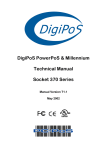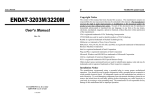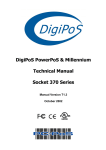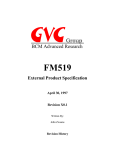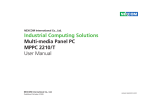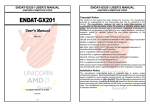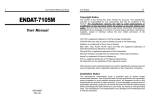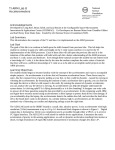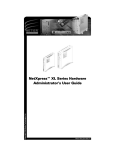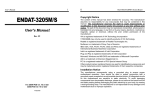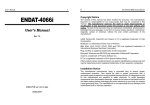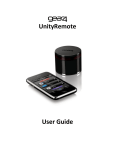Download Manual - UNICORN
Transcript
II ENDAT-3201M/MF/MH User’s Manual Rev. 4x The low power consumption CPU embedded board Copyright Notice The content of this manual has been checked for accuracy. The manufacturer assumes no responsibility for any inaccuracies that may be contained in this manual. The manufacturer reserves the right to make improvements or modification to this document and/or the product at any time without prior notice. No part of this document may be reproduced, transmitted, photocopied or translated into any language, in any form or by any means, electronic, mechanical, magnetic, optical or chemical, without the prior written permission of the manufacturer. VIA is registered trademark of VIA Technology Incorporation VT82C686B may only be used to identify products of VIA Technology Realtek is registered trademark of Realtek Technologies Inc. Multiscan is a trademark of Sony Corp of America IBM, EGA, VGA, PC/XT, PC/AT, OS/2 and PS/2 are registered trademarks of International Business Machines Corporation Intel is a registered trademark of Intel Corporation Plug and Play is registered trademarks of Intel Corporation Microsoft, Windows and MS-DOS are trademarks of Microsoft Corporation AMI is a trademark of American Megatrends Inc. PCI is a registered trademark of PCI Special Interest Group Other product names mentioned herein are used for identification purpose only and may be trademarks and/or registered trademarks of their respective companies. Installation Notice The manufacturer recommends using a grounded plug to ensure proper motherboard operation. Care should be used in proper conjunction with a grounded power receptacle to avoid possible electrical shock. All integrated circuits on this motherboard are sensitive to static electricity. To avoid damaging components from electrostatic discharge, please do not remove the board from the anti-static packing before discharging any static electricity to your body, by wearing a wrist-grounding strap. The manufacturer is not responsible for any damage to the motherboard due to improper operation. For 3201M/MF/MH PCB ver. 2x or later 7/22/2004 III User’s Manual Specification: This manual covers three different layout models, and the respective board layouts are shown in chapter 1-4. Please refer to the following description to make sure which model on hand before using. ENDAT-3201M ENDAT-3201MF ENDAT-3201MH System Chipset VIA VT8601A + VIA VT82C686B (APOLLO PLE-133) Micro Processor Embedded Low Power Consumption VIA Eden or C3 CPU Memory 1 DIMM Socket up to 512MB (max) Ethernet 10/100 BaseT LAN onboard (Realtek 8139C or Intel 82559ER) LCD / VGA Support 24 Bits TFT LCD Panel with 2D / 3D Graphic Controller, SMA up to 8MB IDE Connector 1x Enhance IDE Connectors Support UDMA 33/66/100 FDD Connector 1x FDD Connector Expansion Slot 1x 188Pin EISA Connector for PCI/ISA expansion. Flash Memory Keyboard / Mouse LAN/USB COM 1 COM 2 COM 3 COM 4 LPT 1 LPT 2 VGA TFT LCD Connector LVDS output Watch Dog Timer RS-422/485 COM Port Power Reserved Socket for DOC 2000 support Double-Deck + Pin Header USB+LAN Double-Deck & USB Pin Header Double-Deck (COM 1+LPT1+VGA) D-SUB D-SUB D-SUB Double-Deck (COM1+LPT 1+VGA) Box Header Double-Deck (COM1+LPT1+VGA) Double-Deck + Pin Header USB+LAN Double-Deck & USB Pin Header Double-Deck (COM 1+LPT1+VGA) D-SUB Box Header Box Header Double-Deck (COM1+LPT 1+VGA) Box Header Double-Deck (COM1+LPT1+VGA) & Box Header for VGA Pin Header USB Pin Header RJ-45 LAN Jack Box Header Box Header Box Header Box Header Box Header Box Header Box Header 44 Pin Box Header Optional LVDS for LCD output via 16 Pin Pin Header. Optional programmable Watch Dog Timer support 1-255s. Optional via COM2 4 Serial port support Standard RI. / +5V / +12V power via Pin 9 Power Supply AT or ATX Power support. Form Factor SBC / 203mm x 146mm (7.99” x 5.74”) IV The low power consumption CPU embedded board VI TABLE OF CONTENTS CHAPTER 1. INTRODUCTION.............................................................1 1-1. 1-2. 1-3. 1-4. 1-5. 1-6. FEATURES............................................................................................................2 UNPACKING ........................................................................................................5 ELECTROSTATIC DISCHARGE PRECAUTIONS ............................................5 MOTHERBOARD LAYOUT (ENDAT-3201M)..................................................6 MOTHERBOARD LAYOUT (ENDAT-3201MF) ..............................................7 MOTHERBOARD LAYOUT (ENDAT-3201MH) ..............................................8 CHAPTER 2. SETTING UP THE MOTHERBOARD..........................9 2-1. JUMPERS AND CONNECTORS (ENDAT-3201M) ............................................9 2-2. JUMPERS AND CONNECTORS (ENDAT-3201MF)........................................16 2-3. JUMPERS AND CONNECTORS (ENDAT-3201MH) .......................................23 2-4. INSTALLING MEMORY ....................................................................................30 2-5. SHARED VGA MEMORY ..................................................................................30 2-6. INSTALLING RISER CARD...............................................................................30 2-7. ASSIGNING IRQs FOR EXPANSION CARDS..................................................31 2-8. ASSIGNING DMA CHANNELS FOR ISA CARDS...........................................32 CHAPTER 3. AMI BIOS SETUP ..........................................................33 3-1. QUICK SETUP.....................................................................................................34 3-2. DESCRIPTION OF BIOS SETUP OPTIONS......................................................34 3-3. ADVANCED CMOS SETUP ...............................................................................35 3-4. DETAILS OF THE ADVANCED CHIPSET SETUP...........................................37 3-5. POWER MANAGEMENT SETUP......................................................................39 3-6. PCI / PLUG AND PLAY SETUP .........................................................................41 3-7. PERIPHERALS SETUP .......................................................................................43 3-8. HARDWARE MONITOR SETUP .......................................................................46 The low power consumption CPU embedded board CHPATER 4. VGA, LCD, DOC FEATURE .........................................47 4-1. AGP-BUS VGA FEATURE..................................................................................47 4-2. LCD FLAT PANEL FEATURE ............................................................................48 4-3. PCI BUS AUDIO ADAPTER FEATURES ..........................................................49 4-4. DISKONCHIP FEATURE ....................................................................................50 4-5. DRIVER UTILITY INSTALLATION GUIDE ....................................................51 CHPATER 5. LAN ADAPTER...............................................................53 5-1. FEATURES...........................................................................................................53 5-2. UTP CABLE/RJ-45 JACK DEFINITION ............................................................54 5-3. CONNECTING 100BASE-TX FAST ETHERNET NETWORK ........................55 5-4. CONNECTING 10BASE-T ETHERNET NETWORK .......................................55 5-5. 10M BASE/100MBASE INSTALLATION NOTICE ..........................................55 5-6. REMOTE BOOT FUNCTION .............................................................................56 5-7. LED INDICATORS ..............................................................................................57 5-8. THE SETUP PROGRAM ....................................................................................57 APPENDIX A: FLASH MEMORY UTILITY .....................................61 APPENDIX B: CONNECTOR PIN ASSIGNMENT ...........................62 APPENDIX C: APM FUNCTION .........................................................72 APPENDIX D: LIMITED WARRANTY ..............................................74 2 Chapter 1. Introduction In order to cope with the challenges of the heating issues and demand of much more diminutive embedded system in diverse application, ENDAT-3201M/MF/MH series CPU boards provides the ultimate solution by integrating with VIA’s technology low power consumption VIA C3 series CPU and VIA EDEN fanless ESP series CPU. ENDAT-3201M series CPU boards offer the assorted functions for various applications such as high-end POS systems, kiosks, networking systems, controlling terminals and other embedded systems. ENDAT-3201M/MF/MH is a 5.25” SBC uses VIA chipsets built-in VGA and Audio feature onboard, support TFT TTL LCD feature with LVDS interface as feature option; integrated Super-I/O support 4 Serial with power selector and 2 parallel ports, built-in Realtek 8139x LAN chipset with RJ45 Jack for 10BaseT/ 100BaseT. The option of Intel 82551QM/ER chip is also provided for the LAN support. This SBC offers the highest performance PC specification in the industry with embedded low power consumption VIA EDEN Fanless ESP series CPU ESP5000, and with the option of the higher performed VIA C3 800MHz CPU. For easier assembly and better integration without arranging array of cables, the ENDAT-3201M/MF provides onboard connectors with a similar conventional ATX IO connector layout; as for ENDAT-3201MH leaves the flexibilities of cable connections similar to the standard 5.25” SBC. ENDAT-3201M/MF/MH provides the option of integrating Watch Dog Timer for ideal unattended terminals. To offer better flexibility, it also provides the options of riser card for PCI or ISA expansion through a 188-pin slot. This CPU board is fully compatible with industry standards, adding many technical enhancements and are fully compatible with thousand of software application such as WIN 95, 98, WIN NT 3.x / 4.x, WIN 2000, WIN XP, WIN ME, WIN CE (.NET), (Embedded XP), Linux, UNIX, Novell…etc. The control logic provides high-speed performance for the most advanced multi-user, multitasking application available today. “Tomorrow’s PC technology is here today”. The ENDAT-3201M/MF/MH Embedded CPU Board 1-1. Features Basic Feature: z z z z z z z z z ENDAT-3201M/MF/MH, embedded VIA C3 TM, Eden TM Low Power EBGA processors. 133 / 100 MHz CPU Front Side Bus (FSB) DRAM interface synchronous or pseudo synchronous with CPU FSB speed of 133 / 100 / 66 MHz Mixed 1M / 2M / 4M / 8M / 16M / 32MxN DRAMs 1 DIMM 168 Pin socket supported up to 512MB 3.3V DRAM interface with 5V-tolerant inputs z Support single channel support two UltraDMA-100 / 66 / 33 enhance IDE AC-97 link. On-board built-in 2 USB ports. Integrated Super-I/O support 4 Serial with power selector and 2 parallel ports. Optional RS-422/485 via COM2 z z z System Hardware monitoring Keyboard / mouse interfaces. RTC / CMOS z z z z z z PCI-2.0 compliant, 32 bit with 5V tolerant inputs. 33 MHz operation on the primary PCI bus 188pin expansion slot for both PCI and ISA Bus signals. PC99 Hardware Support Watch-Dog-Timer support 1-255sec programmable. On-board support Realtek or Intel 82551QM/ER 10/100 LAN adapter with RJ-45 port. AGP v2.x compliant Integrated AGP Bus 2D / 3D graphic accelerator. Windows 95 OSR-2 VXD and integrated Windows 98 / NT 4.0 miniport driver support BIOS shadow at 16KB increment z z z z User’s Manual z z z z 3 Supports 2, 4 and 8 Mbytes of Frame Buffer with share memory. DirectDrawTM and DirectVideoTM Hardware Support Advanced Mobile Power Management CRT Power Management (VESA™ DPMS) Optional for Flat Panel Interface (TTL or LVDS) The board is designed to support industry standard TFT panel via 44pin connector or LVDS transmitters. The interface supports both 18-bit and 24-bit display modes. Optional Features • • • • • • Supports RS422/RS485 interface with COM2 Support LVDS LCD panel Supports Audio function (via AV Card Kit) Supports TV-Out feature (via TV-Out adapter Kit) Support Watch Dog Timer Support BOOT ROM Ordering information: ENDAT-3201M 1. ENDAT-3201M-1R: Support 1 Realtek LAN 2. ENDAT-3201M-1i: Support 1 Intel LAN 3. ENDAT-3201M-1RL: Support 1 Realtek LAN + LVDS 4. ENDA-3201M-1iL: Support 1 Intel LAN + LVDS ENDAT-3201MF 1. ENDAT-3201MF-1R: Support 1 Realtek LAN 2. ENDAT-3201MF-1i: Support 1 Intel LAN 3. ENDAT-3201MF-1RL: Support 1 Realtek LAN + LVDS 4. ENDA-3201MF-1iL: Support 1 Intel LAN + LVDS 4 The ENDAT-3201M/MF/MH Embedded CPU Board ENDAT-3201MH 1. ENDAT-3201MH-1R: Support 1 Realtek LAN 2. ENDAT-3201MH-1i: Support 1 Intel LAN 3. ENDAT-3201MH-1RL: Support 1 Realtek LAN + LVDS 4. ENDA-3201MH-1iL: Support 1 Intel LAN + LVDS Note: The standard version of ENDAT-3201M/MF/MH is embedded with VIA EDEN Fanless ESP5000. Other option CPUs will be provided upon request. User’s Manual 5 1-2. Unpacking The motherboard comes securely packaged in a sturdy cardboard shipping carton. In addition to the User's Manual, the motherboard package includes the following items: • • • • • • ENDAT-3201M/MF/MH 5.25” SBC / CPU Board HDD/FDD Cables TV-Out adapter / cable (Optional) Audio Kit (Optional) LCD cable (Optional) IDE Driver includes: Drivers for Windows NT 3.x/4.x, Windows 95, 98, 2000, XP, Win Me, Linux, Novell Netware and AMI FLASH ROM utilities. • Driver utilities for on-board VGA drivers, LAN adapter and DOC 2000 If any of these items are missing or damage, please contact the dealer from whom you purchase the motherboard. Save the shipping material and carton in the event that you want to ship or store the board in the future. Note: Leave the motherboard in its original package until you are ready to install it! 1-3. Electrostatic Discharge Precautions Make sure you properly ground yourself before handling the motherboard, or other system components. Electrostatic discharge can easily damage the components. Note: You must take special precaution when handling the motherboard in dry or air-conditioned environments. 6 1-4. ENDAT-3201M The ENDAT-3201M/MF/MH Embedded CPU Board User’s Manual 1-5. ENDAT-3201MF 7 8 1-6. ENDAT-3201MH The ENDAT-3201M/MF/MH Embedded CPU Board 10 Chapter 2. Setting up the CPU Motherboard 2-1. Jumpers and Connectors (ENDAT-3201M) Jumpers/Connectors Overview: Function Cooling Fan Connector Power Supply: Power Good ATX Power On/Off Switch Audio Port Connector 2nd Printer Port LAN Adapter Disable/Enable COM1 Port COM2 Port COM3 Port COM4 Port COM Ports Power Selector (COM1, 2, 3, 4) RS232/RS422/RS485 Selector (COM2) USB Port DiskOnChip Memory Address LCD: TFT LCD Panel Connector LVDS LCD Output Port LCD Voltage/ LVDS Trigger Edge Selector Clear CMOS Factory Setting PS/2 Keyboard Jack PS/2 Mouse Jack PS/2 Mouse/KB Pin Header IR FDD Connector Jumpers/Connectors JFAN1, JFAN2 JP12: Pin 9~11 JP12: Pin 12~13 CN1 CN4 JP3 CN6 CN8 CN2 CN3 JP4, JP9 JP10, JP11 Double-Deck; JUSB1 (Pin Header) JP15 LCD-CON1 CN5 JP7 JP2 JP1, JP5, JP8, JP13, JP14, JT1, JH1 JKBMS JKBMS CN7 J1 FDD1 The ENDAT-3201M/MF/MH Embedded CPU Board Function IDE 1 Header for Case Panel IDE 1 LED External Speaker Buzzer On/Off Hardware Reset Switch External Power Good Internal Power Good ATX Power Supply On/Off Switch Power LED WDT Function Enable/Disable Jumpers/Connectors IDE1 JP12 JP12: Pin 1 (–), Pin 2 (+) JP12: Pin 3, Pin 6 JP12: Pin 4, Pin 5 JP12: Pin 7, Pin 8 JP12: Pin 9, Pin 10 JP12: Pin 10, Pin 11 JP12: Pin 12, Pin 13 JP12: Pin 14 (+), Pin 15 (–) JP12: Pin 19, Pin 20 JP2: CMOS Data Clear: Normal Clear CMOS Data Pin 1-2 * Pin 2-3 JP15: DiskOnChip Memory Address Selector JP15 1-2 1-2 3-4 3-4 5-6 7-8 9-10 7-8 9-10 7-8 Memory Address 0C800H-0C9FFH 0CC00H-0CDFFH 0D000H-0D1FFH 0D400H-0D5FFH 0D800H-0D9FFH * JP3: On-board LAN Disable/Enable Pin 1-2 * Pin 2-3 Enable On-Board LAN Disable On-Board LAN JP9 (COM1, 2) / JP4 (COM3, 4) Voltage Selector: Voltage +12V(DC) R.I. * +5V(DC) COM1(JP9) COM2(JP9) COM3(JP4) COM4(JP4) 1-2 7-8 1-2 7-8 3-4 9-10 3-4 9-10 5-6 11-12 5-6 11-12 11 User’s Manual JP10, JP11: RS232 / 422 / 485 Selector for COM2 TYPE JP10 JP11 RS-232 * 1-2, 4-5, 7-8, 10-11 1-2 RS-422/485 Full Duplex 2-3, 5-6, 8-9, 11-12 3-4, 7-8 * Make sure the port mode is set up correctly before installing any peripherals. ** Please also refer to the Appendix B for the pin assignments JP12’s Pin 9~11: On-board Power Good Selector Pin 9-10 * Pin 10-11 Using External Power Good Using On Board Power Good JFAN1, JFAN2: CPU / 2nd Cooling Fan Connector Pin No. Pin 1 Pin 2 Pin 3 Function Sensor Pin. +12V GND JP12’s Pin12;13: For ATX Power Supply Pin 12; Pin 13 On/Off Switch for ATX Power JP12: Case Panel Connection: Pin No. 1,2 3,6 4,5 7-8 9-10 10-11 12-13 14-15 19-20 Description HDD_LED (1: LED–, 2: LED+) External Speaker Onboard Buzzer Hardware RESET External Power Good Internal Power Good ATX Power On/Off Power LED (14:LED+, 15:LED–) Close: Enable WDT function 12 The ENDAT-3201M/MF/MH Embedded CPU Board CN1: Audio Output Port connector via AV Card Kit (Optional) Please close pin13-14 to disable onboard Audio features if the AV Card Kit is not inserted onto the CN1 connector. If AV card kit is inserted, please make sure the BIOS is enabled with the audio function, since LPT2 and audio function can not be used in the same time. CN1: Audio Port. Pin No. 1 3 5 7 9 11 13 15 17 19 21 23 25 Function BITCLK SDIN SDIN2 SDOUT SYNC –ACRST SPEAK +5V(DC) JBCY JBCX JACY JACX MSO Pin No. 2 4 6 8 10 12 14 16 18 20 22 24 26 Function GND N.C. N.C. N.C. GND GND Strapping Low +12V(DC) JAB2 JAB1 JBB2 JBB1 MSI J1: IR Pin Header. Pin No. 1 2 3 4 5 Function +5V(DC) N.C. IRRX GND IRTX UC-A003 AV Card 13 User’s Manual Signal (KB) KB Data KEY GND +5V(DC) KB_CLK Pin No. 2 4 6 8 10 Signal(MS) MS Data KEY GND +5V(DC) MS_CLK Printer (LPT1/LPT2) Port Pin No. 1 2 3 4 5 6 7 8 9 Description STB# PD0 PD1 PD2 PD3 PD4 PD5 PD6 PD7 Pin No. 10 11 12 13 14 15 16 17 18-25 Description ACK# BUSY PE SLCT AFD# ERR# INIT# SLIN# GND JKBM2 KB-Controller interface Header for Special OEM design: Pin No. Description 1 KB_JDT 2 KB_DATA 3 KB_JCK 4 KB_CLK 5 KEY 6 KB_VCC Add in Rev.1B 7 GND Add in Rev.1B * Default close 1-2 and 3-4 for Normal operation. JUSB1 Header Pin No. 1 3 5 7 9 Description USB_VCC USB_DATA3– USB_DATA3+ USB_GND USB_GND Pin No. 2 4 6 8 10 The ENDAT-3201M/MF/MH Embedded CPU Board CN5: LCD - LVDS Output. CN7: Pin Header for PS2 KB / MS Pin No. 1 3 5 7 9 14 Description USB_VCC USB_DATA2– USB_DATA2+ USB_GND USB_GND Pin No. 1 3 5 7 9 11 13 15 Signal Y0– Y0+ Y1– GND Y1+ CK– CK+ VBL Pin No. 2 4 6 8 10 12 14 16 Signal Y2– Y2+ VDD_LVDS Y3– Y3+ VDD_LVDS DISP_OFF GND LCD_CON1: TFT LCD Panel Port Pin No. Signal Pin No. Signal 1 VBL 2 VBL 3 GND 4 GND 5 VDDLCD 6 VDDLCD 7 ENPVEE 8 GND 9 FPD 23 10 FPD 22 11 FPD 17 12 FPD 16 13 FPD 11 14 FPD 10 15 FPD 9 16 FPD 8 17 FPD 21 18 FPD 20 19 FPD 15 20 FPD 14 21 FPD 7 22 FPD 6 23 FPD 5 24 FPD 4 25 FPD 19 26 FPD 18 27 FPD 13 28 FPD 12 29 FPD 3 30 FPD 2 31 FPD 1 32 FPD 0 33 GND 34 GND 35 P_CLK 36 V-SYNC (FLM) 37 DE 38 H-SYNC (LP) 39 GND 40 VDDLCD 41 VDDLCD 42 KEY 43 VDDLCD 44 VDDLCD * Please make sure the Pin 1 location before inserting the LCD connector. Please double-check the insertion and orientation of the LCD cable before applying power. Improper installation will result in permanent damage LCD panel. User’s Manual 15 16 The ENDAT-3201M/MF/MH Embedded CPU Board Factory Setting: 2-2. Jumpers and Connectors (ENDAT-3201MF) JP1: All Pin Open JP7: LCD Voltage selector Voltage JP7 3.3V 4-6 * 5V 2-4 JP7: LVDS Trigger Edge Edge JP7 Falling 3-5 Rising 1-3 * JP8: Close Pin 1-2 JP13: Factory Using only JP14: Close Pin 2-3; Pin 5-6; Pin 8-9; Pin 11-12 JT1: Close Pin 2-3; Pin 4-5; Pin 8-9 JH1: Close Pin 1-2; Pin 5-6; Pin 7-8 Jumpers/Connectors Overview: Function Cooling Fan Connector Power Supply: Power Good ATX Power On/Off Switch Audio Port Connector 2nd Printer Port LAN Adapter Disable/Enable VGA Port COM1 Port COM2 Port COM3 Port COM4 Port COM Ports Power Selector (COM1, 2, 3, 4) RS232/RS422/RS485 Selector (COM2) USB Port DiskOnChip Memory Address LCD: TFT LCD Panel Connector LVDS LCD Output Port LCD Voltage/ LVDS Trigger Edge Selector Clear CMOS Factory Setting PS/2 Keyboard Jack PS/2 Mouse Jack PS/2 Mouse/KB Pin Header IR FDD Connector IDE 1 Jumpers/Connectors JFAN1, JFAN2 JP12: Pin 9~11 JP12: Pin 12~13 CN1 CN4 JP3 VGA1 (D-SUB); VGAC1 (16 Pin Box Header) CN6 CN8 CN2 CN3 JP4, JP9 JP10, JP11 Double-Deck; JUSB1, JUSB2 (Pin Header) JP15 LCD-CON1 CN5 JP7 JP2 JP1, JP5, JP8, JP13, JP14, JT1, JH1 JKBMS JKBMS CN7 J1 FDD1 IDE1 17 User’s Manual Function Header for Case Panel IDE 1 LED External Speaker Buzzer On/Off Hardware Reset Switch External Power Good Internal Power Good ATX Power Supply On/Off Switch Power LED WDT Function Enable/Disable Jumpers/Connectors JP12 JP12: Pin 1 (–), Pin 2 (+) JP12: Pin 3, Pin 6 JP12: Pin 4, Pin 5 JP12: Pin 7, Pin 8 JP12: Pin 9, Pin 10 JP12: Pin 10, Pin 11 JP12: Pin 12, Pin 13 JP12: Pin 14 (+), Pin 15 (–) JP12: Pin 19, Pin 20 COM3 (CN2) / COM4 (CN3) Box Header: Pin No. 1 2 3 4 5 Description DCD RXD TXD DTR GND Pin No. 6 7 8 9 10 Description DSR RTS CTS RI / PWR N.C. VGAC1 (VGA) OUPTUT (Box Header Type): Pin No. Description Pin No. Description 1 RED 9 N.C./ +5V 2 GREEN 10 VGA_GND 3 BLUE 11 N.C. 4 N.C. 12 I2C_DATA 5 VGA_GND 13 H_SYNC 6 VGA_GND 14 V_SYNC 7 VGA_GND 15 I2C _CLK 8 VGA_GND 16 N.C. Note: Factory default setting for pin 9 is “NC”; only when use with UC-TS003 (TV OUT card) +5V power source is provided Note 1: When +5V is provided by pin 9, the mono type CRT monitor is not recommended to be used 18 The ENDAT-3201M/MF/MH Embedded CPU Board JKBM2 KB-Controller interface Header for Special OEM design: Pin No. Description 1 KB_JDT 2 KB_DATA 3 KB_JCK 4 KB_CLK 5 KEY 6 KB_VCC Add in Rev.1B 7 GND Add in Rev.1B * Default close 1-2 and 3-4 for Normal operation. JUSB1 Header Pin No. 1 3 5 7 9 Description USB_VCC USB_DATA3– USB_DATA3+ USB_GND USB_GND Pin No. 2 4 6 8 10 Description USB_VCC USB_DATA2– USB_DATA2+ USB_GND USB_GND Pin No. 2 4 6 8 10 Description USB_VCC USB_DATA0– USB_DATA0+ USB_GND USB_GND JUSB2 Header Pin No. 1 3 5 7 9 Description USB_VCC USB_DATA1– USB_DATA1+ USB_GND USB_GND JP2: CMOS Data Clear: Pin 1-2 * Normal Pin 2-3 Clear CMOS Data JP15: DiskOnChip Memory Address Selector JP15 1-2 1-2 3-4 3-4 5-6 7-8 9-10 7-8 9-10 7-8 Memory Address 0C800H-0C9FFH 0CC00H-0CDFFH 0D000H-0D1FFH 0D400H-0D5FFH 0D800H-0D9FFH * 19 User’s Manual JP3: On-board LAN Disable/Enable Pin 1-2 * Pin 2-3 Enable On-Board LAN Disable On-Board LAN JP9 (COM1, 2) / JP4 (COM3, 4) Voltage Selector: Voltage +12V(DC) R.I. * +5V(DC) COM1(JP9) COM2(JP9) COM3(JP4) COM4(JP4) 1-2 7-8 1-2 7-8 3-4 9-10 3-4 9-10 5-6 11-12 5-6 11-12 JP10, JP11: RS232 / 422 / 485 Selector for COM2 TYPE JP10 JP11 RS-232 * 1-2, 4-5, 7-8, 10-11 1-2 RS-422/485 Full Duplex 2-3, 5-6, 8-9, 11-12 3-4, 7-8 * Make sure the port mode is set up correctly before installing any peripherals. ** Please also refer to the Appendix B for the pin assignments JP12’s Pin 9~11: On-board Power Good Selector Using External Power Good Using On Board Power Good Pin 9-10 * Pin 10-11 JFAN1, JFAN2: CPU / 2nd Cooling Fan Connector Pin No. Pin 1 Pin 2 Pin 3 Function Sensor Pin. +12V GND JP12’s Pin12;13: For ATX Power Supply Pin 12; Pin 13 On/Off Switch for ATX Power JP12: Case Panel Connection: Pin No. 1,2 3,6 4,5 7-8 9-10 10-11 12-13 14-15 19-20 20 The ENDAT-3201M/MF/MH Embedded CPU Board J1: IR Pin Header. Pin No. 1 2 3 4 5 Function +5V(DC) N.C. IRRX GND IRTX CN1: Audio Output Port connector via AV Card Kit (Optional) Please close pin13-14 to disable onboard Audio features if the AV Card Kit is not inserted onto the CN1 connector. If AV card kit is inserted, please make sure the BIOS is enabled with the audio function, since LPT2 and audio function can not be used in the same time. CN1: Audio Port. Pin No. 1 3 5 7 9 11 13 15 17 19 21 23 25 Function BITCLK SDIN SDIN2 SDOUT SYNC –ACRST SPEAK +5V(DC) JBCY JBCX JACY JACX MSO Pin No. 2 4 6 8 10 12 14 16 18 20 22 24 26 Function GND N.C. N.C. N.C. GND GND Strapping Low +12V(DC) JAB2 JAB1 JBB2 JBB1 MSI Description HDD_LED (1: LED–, 2: LED+) External Speaker Onboard Buzzer Hardware RESET External Power Good Internal Power Good ATX Power On/Off Power LED (14: LED+, 15: LED–) Close: Enable WDT function UC-A003 AV Card 21 User’s Manual CN7: Pin Header for PS2 KB / MS Pin No. 1 3 5 7 9 Signal (KB) KB Data KEY GND +5V(DC) KB_CLK Pin No. 2 4 6 8 10 Signal(MS) MS Data KEY GND +5V(DC) MS_CLK Printer (LPT1/LPT2) Port Pin No. 1 2 3 4 5 6 7 8 9 Description STB# PD0 PD1 PD2 PD3 PD4 PD5 PD6 PD7 Pin No. 10 11 12 13 14 15 16 17 18-25 Description ACK# BUSY PE SLCT AFD# ERR# INIT# SLIN# GND CN5: LCD - LVDS Output. Pin No. 1 3 5 7 9 11 13 15 Signal Y0– Y0+ Y1– GND Y1+ CK– CK+ VBL Pin No. 2 4 6 8 10 12 14 16 Signal Y2– Y2+ VDD_LVDS Y3– Y3+ VDD_LVDS DISP_OFF GND LCD_CON1: TFT LCD Panel Port Pin No. 1 3 5 7 9 Signal VBL GND VDDLCD ENPVEE FPD 23 Pin No. 2 4 6 8 10 Signal VBL GND VDDLCD GND FPD 22 22 The ENDAT-3201M/MF/MH Embedded CPU Board Pin No. 11 13 15 17 19 21 23 25 27 29 31 33 35 37 39 41 43 Signal FPD 17 FPD 11 FPD 9 FPD 21 FPD 15 FPD 7 FPD 5 FPD 19 FPD 13 FPD 3 FPD 1 GND P_CLK DE GND VDDLCD VDDLCD Pin No. 12 14 16 18 20 22 24 26 28 30 32 34 36 38 40 42 44 Signal FPD 16 FPD 10 FPD 8 FPD 20 FPD 14 FPD 6 FPD 4 FPD 18 FPD 12 FPD 2 FPD 0 GND V-SYNC (FLM) H-SYNC (LP) VDDLCD KEY VDDLCD * Please make sure the Pin 1 location before inserting the LCD connector. Please double-check the insertion and orientation of the LCD cable before applying power. Improper installation will result in permanent damage LCD panel. Factory Setting: JP1: All Pin Open JP7: LCD Voltage selector Voltage JP7 3.3V 4-6 * 5V 2-4 JP7: LVDS Trigger Edge Edge JP7 Falling 3-5 Rising 1-3 * JP8: Close Pin 1-2 JP13: Factory Using only JP14: Close Pin 2-3; Pin 5-6; Pin 8-9; Pin 11-12 JT1: Close Pin 2-3; Pin 4-5; Pin 8-9 JH1: Close Pin 1-2; Pin 5-6; Pin 7-8 23 User’s Manual 2-3. Jumpers and Connectors (ENDAT-3201MH) Jumpers/Connectors Overview: Function Cooling Fan Connector Power Supply: Power Good ATX Power On/Off Switch Audio Port Connector 2nd Printer Port LAN Adapter Disable/Enable VGA Port COM1 Port COM2 Port COM3 Port COM4 Port COM Ports Power Selector (COM1, 2, 3, 4) RS232/RS422/RS485 Selector (COM2) USB Port DiskOnChip Memory Address LCD: TFT LCD Panel Connector LVDS LCD Output Port LCD Voltage/LVDS Trigger Edge Selector Clear CMOS Factory Setting PS/2 Mouse/KB Pin Header IR FDD Connector IDE 1 Header for Case Panel IDE 1 LED External Speaker Buzzer On/Off Jumpers/Connectors JFAN1, JFAN2 JP12: Pin 9~11 JP12: Pin 12~13 CN1 CN4 JP3 VGA1 CN6 CN8 CN2 CN3 JP4, JP9 JP10, JP11 JUSB1, JUSB2 JP15 LCD-CON1 CN5 JP7 JP2 JP1, JP5, JP8, JP13, JP14, JT1, JH1 CN7 J1 FDD1 IDE1 JP12 JP12: Pin 1 (–), Pin 2 (+) JP12: Pin 3, Pin 6 JP12: Pin 4, Pin 5 24 The ENDAT-3201M/MF/MH Embedded CPU Board Function Hardware Reset Switch External Power Good Internal Power Good ATX Power Supply On/Off Switch Power LED Jumpers/Connectors JP12: Pin 7, Pin 8 JP12: Pin 9, Pin 10 JP12: Pin 10, Pin 11 JP12: Pin 12, Pin 13 JP12: Pin 14 (+), Pin 15 (–) WDT Function Enable/Disable JP12: Pin 19, Pin 20 COM1 (CN6) / COM2 (CN8) / COM3 (CN2) / COM4 (CN3) Box Header: Pin No. 1 2 3 4 5 Description DCD RXD TXD DTR GND Pin No. 6 7 8 9 10 Description DSR RTS CTS RI / PWR N.C. VGA1 (VGA) Output (Box Header Type) Pin No. Description Pin No. Description 1 RED 9 Reserved 2 GREEN 10 VGA_GND 3 BLUE 11 N.C. 4 N.C. 12 I2C_DATA 5 VGA_GND 13 H_SYNC 6 VGA_GND 14 V_SYNC 7 VGA_GND 15 I2C _CLK 8 VGA_GND 16 N.C. Note: Factory default setting for pin 9 is “NC”; only when use with UC-TS003 (TV OUT card) +5V power source is provided Note 1: When +5V is provided by pin 9, the mono type CRT monitor is not recommended to be used 25 User’s Manual Description USB_VCC USB_DATA3– USB_DATA3+ USB_GND USB_GND Pin No. 2 4 6 8 10 Description USB_VCC USB_DATA2– USB_DATA2+ USB_GND USB_GND Pin No. 2 4 6 8 10 Description USB_VCC USB_DATA0– USB_DATA0+ USB_GND USB_GND JUSB2 Header Pin No. 1 3 5 7 9 Description USB_VCC USB_DATA1– USB_DATA1+ USB_GND USB_GND JKBMS2 KB-Controller interface Header for Special OEM design: Pin No. Description 1 KB_JDT 2 KB_DATA 3 KB_JCK 4 KB_CLK 5 KEY 6 KB_VCC Add in Rev.1B 7 GND Add in Rev.1B * Default close 1-2 and 3-4 for Normal operation. JP2: CMOS Data Clear: Pin 1-2 * Pin 2-3 JP15 7-8 9-10 7-8 9-10 7-8 Pin 1-2 * Pin 2-3 Enable On-Board LAN Disable On-Board LAN JP9 (COM1, 2) / JP4 (COM3, 4) Voltage Selector: Voltage +12V(DC) R.I. * +5V(DC) COM1(JP9) COM2(JP9) COM3(JP4) COM4(JP4) 1-2 7-8 1-2 7-8 3-4 9-10 3-4 9-10 5-6 11-12 5-6 11-12 JP10, JP11: RS232 / 422 / 485 Selector for COM2 TYPE JP10 JP11 RS-232 * 1-2, 4-5, 7-8, 10-11 1-2 RS-422/485 Full Duplex 2-3, 5-6, 8-9, 11-12 3-4, 7-8 * Make sure the port mode is set up correctly before installing any peripherals. ** Please also refer to the Appendix B for the pin assignments JP12’s Pin 9~11: On-board Power Good Selector Pin 9-10 * Pin 10-11 Using External Power Good Using On Board Power Good JFAN1, JFAN2: CPU / 2nd Cooling Fan Connector Pin No. Pin 1 Pin 2 Pin 3 Function Sensor Pin. +12V GND JP12’s Pin12;13: For ATX Power Supply Pin 12; Pin 13 Normal Clear CMOS Data JP15: DiskOnChip Memory Address Selector 1-2 1-2 3-4 3-4 5-6 The ENDAT-3201M/MF/MH Embedded CPU Board JP3: On-board LAN Disable/Enable JUSB1 Header Pin No. 1 3 5 7 9 26 Memory Address 0C800H-0C9FFH 0CC00H-0CDFFH 0D000H-0D1FFH 0D400H-0D5FFH 0D800H-0D9FFH * On/Off Switch for ATX Power JP12: Case Panel Connection: Pin No. 1,2 3,6 4,5 7-8 9-10 10-11 12-13 14-15 19-20 Description HDD_LED (1:LED–, 2: LED+) External Speaker Onboard Buzzer Hardware RESET External Power Good Internal Power Good ATX Power On/Off Power LED (14:LED+, 15:LED-) Close: Enable WDT function 27 User’s Manual J1: IR Pin Header. Pin No. 1 2 3 4 5 The ENDAT-3201M/MF/MH Embedded CPU Board CN7: Pin Header for PS2 KB / MS Function +5V(DC) N.C. IRRX GND. IRTX Pin No. 1 3 5 7 9 CN1: Audio Output Port connector via AV Card Kit (Optional) Please close pin13-14 to disable onboard Audio features if the AV Card Kit is not inserted onto the CN1 connector. If AV card kit is inserted, please make sure the BIOS is enabled with the audio function, since LPT2 and audio function can not be used in the same time. CN1: Audio Port. Pin No. 1 3 5 7 9 11 13 15 17 19 21 23 25 28 Function BITCLK SDIN SDIN2 SDOUT SYNC –ACRST SPEAK +5V(DC) JBCY JBCX JACY JACX MSO Pin No. 2 4 6 8 10 12 14 16 18 20 22 24 26 Function GND N.C. N.C. N.C. GND GND Strapping Low +12V(DC) JAB2 JAB1 JBB2 JBB1 MSI Signal (KB) KB Data KEY GND +5V(DC) KB_CLK Pin No. 2 4 6 8 10 Signal(MS) MS Data KEY GND +5V(DC) MS_CLK Printer (LPT1/LPT2) Port Pin No. 1 2 3 4 5 6 7 8 9 Description STB# PD0 PD1 PD2 PD3 PD4 PD5 PD6 PD7 Pin No. 10 11 12 13 14 15 16 17 18-25 Description ACK# BUSY PE SLCT AFD# ERR# INIT# SLIN# GND CN5: LCD - LVDS Output. Pin No. 1 3 5 7 9 11 13 15 Signal Y0– Y0+ Y1– GND Y1+ CK– CK+ VBL Pin No. 2 4 6 8 10 12 14 16 Signal Y2– Y2+ VDD_LVDS Y3– Y3+ VDD_LVDS DISP_OFF GND LCD_CON1: TFT LCD Panel Port Pin No. 1 3 5 7 9 UC-A003 AV Card Signal VBL GND VDDLCD ENPVEE FPD 23 Pin No. 2 4 6 8 10 Signal VBL GND VDDLCD GND FPD 22 User’s Manual 29 11 FPD 17 12 FPD 16 13 FPD 11 14 FPD 10 15 FPD 9 16 FPD 8 17 FPD 21 18 FPD 20 19 FPD 15 20 FPD 14 21 FPD 7 22 FPD 6 23 FPD 5 24 FPD 4 25 FPD 19 26 FPD 18 27 FPD 13 28 FPD 12 29 FPD 3 30 FPD 2 31 FPD 1 32 FPD 0 33 GND 34 V-SYNC (GND) 35 P_CLK 36 H-SYNC (FLM) 37 DE 38 LP 39 GND 40 VDDLCD 41 VDDLCD 42 KEY 43 VDDLCD 44 VDDLCD * Please make sure the Pin 1 location before inserting the LCD connector. Please double-check the insertion and orientation of the LCD cable before applying power. Improper installation will result in permanent damage LCD panel. Factory Setting: JP1: All Pin Open JP7: LCD Voltage selector Voltage JP7 3.3V 4-6 * 5V 2-4 JP7: LVDS Trigger Edge Edge JP7 Falling 3-5 Rising 1-3 * JP8: Close Pin 1-2 JP13: Factory Using only JP14: Close Pin 2-3; Pin 5-6; Pin 8-9; Pin 11-12 JT1: Close Pin 2-3; Pin 4-5; Pin 8-9 JH1: Close Pin 1-2; Pin 5-6; Pin 7-8 30 The ENDAT-3201M/MF/MH Embedded CPU Board 2-4. Installing Memory The ENDAT-3201M/MF/MH CPU board offers one 168pin DIMM sockets supporting up to 512MB of memory. The DIMM memory can be 100MHz (PC-100) or 133 MHz (PC-133). 2-5. Shared VGA Memory The ENDAT-3201M/MF/MH is using built-in AGP VGA controller with share memory architecture (SMA) - AGP mode with 2MB to 8MB of system memory. The amount of video memory on motherboard determines the number of colors and the video graphic resolution. 2-6. Installing Riser Card Installing Riser Card (Max. 3 PCI Slot on Riser Card) PCI Slot PCI 1 PCI 2 PCI 3 PCI 4 INT ADSEL A,B,C,D AD24(Onboard LAN) B,C,D,A AD23 C,D,A,B AD22 D,A,B,C AD21 There are two different riser cards that can be fitted to ENDAT-3201M/MF/MH CPU board. The first one is a 98pin ISA only Bus riser card (traditional ISA Bus riser card), the second one is a 188pins PCI/ISA riser card. Please note: PCI/ISA riser cards jumper settings have to be matched with the motherboard INT/AD-select jumper. The default INT/AD-select for ENDAT-3201M/MF/MH All-In-One motherboard is listed in the above table. However, it could be revised by changing JP14 setting for different INT/AD-select. The following table shows the variable configurations: INT/AD Configurations: Expansion for PCI Slot Expansion PCI 1 Expansion PCI 2 Expansion PCI 3 Expansion PCI 4 * Close 1-2 INT =A,B,C,D INT = B,C,D,A INT = C,D,A,B INT = D,A,B,C Close 2-3 INT = B,C,D,A INT = C,D,A,B INT = D,A,B,C INT = A,B,C,D User’s Manual 31 Note: Even change the setting for different configuration the AD-select should be match to each INT. Please using the default setting as above if you are not familiar with the configuration of raiser card and add-on card. Caution: Do not insert PCI Bus Add-On cards directly into the on-board expansion slot! 2-7. Assigning IRQs for Expansion Cards Some expansion cards require an IRQ (Interrupt request vector) to operate. Generally, each IRQ must be exclusively assigned to specific use. In a standard design, there are 16 IRQ available with 11 of them already in used by other part of the system. Both ISA and PCI expansion cards may need to use IRQ. Cards installed in the ISA Expansion Bus have the first priority to use the available system IRQs. Any remaining IRQ then, may be assigned to this PCI Bus. Microsoft's Diagnostic (MSD.EXE) utility included in the Windows directory can be used to see their map. Make sure that there are no two devices using the same IRQ in the system. Otherwise this will cause the system to hang up or give unexpected results. To simplify the process, this motherboard complies with the Plug and Play (PnP) specifications, which was developed to allow automatic system configuration. Whenever a PnP-compliant card is added to the system, PnP cards and IRQs are automatically assigned if available. If the system has both Legacy and PnP ISA cards installed. IRQs are assigned to PnP cards from those not used by Legacy cards. The PCI and PnP configuration in the BIOS setup utility can be used to indicate which IRQs have being used by Legacy cards. For older Legacy cards that do not work with the BIOS, you can contact your vendor for an ISA configuration utility. An IRQ number is automatically assigned to PCI expansion cards after those used by Legacy and PnP ISA cards. In the PCI Bus design, the BIOS is automatically assigned an IRQ to a PCI slot that has a card in it which requires an IRQ. To install a PCI card, you need to set the correct "ADSEL" and "INT" (interrupt) assignment. Please refer to "Chapter 2-5" Installing a Riser Card for detail assignments. 32 The ENDAT-3201M/MF/MH Embedded CPU Board IRQ 0 1 2 3 4 5 6 7 8 9 10 11 12 13 14 15 Status Used Used Used Used Used Used Used Used Used Used Used Used Used Used Used Used Assignment Timer Keyboard Second 8259 COM2 COM1 COM3 Floppy Disk LPT1 RTC LPT2 or Audio COM4 LAN Adapter (on board) PS/2 Mouse Coprocessor Hard Disk (IDE 1) Reserved (IDE 2) 2-8. Assigning DMA Channels for ISA Cards Since ISA cards, both Legacy and PnP may also need to use a DMA (direct memory access) channel, DMA assignments for this motherboard are handled the same way as the IRQ assignment process described above. You can select a DMA channel in the PCI and PnP configuration section of the BIOS setup utility. In the BIOS setup, you should choose "Yes" for those IRQ's and DMA's you wish to reserve for Legacy cards. 34 Chapter 3. AMI BIOS SETUP AMI BIOS Setup Main Menu Standard CMOS Setup Advanced CMOS Setup Advanced Chipset Setup Power Management Setup PCI / Plug and Play Setup Peripheral Setup Hardware Monitor Setup Auto-Detect Hard Disks Change User Password Change Supervisor Password Auto Configuration with Optimal Settings Save Settings and Exit Exit Without Saving Use the CMOS setup program to modify the system parameters to reflect the environment installed in your system and to customize the system as desired. Press the <DEL> key to enter into the CMOS setup program when you turn on the power. Settings can be accessed via arrow keys. Press <Enter> to choose an option to configure the system properly. In the main menu, press F10 or “Save Settings and Exit” to save your changes and reboot the system. Choose “Exit Without Saving” to ignore the changes and exit the setup procedure. Pressing <ESC> at anywhere during the setup will return to the main menu. “Advanced CMOS Setup”, “Details of the Advanced Chipset Features” and “PCI / Plug and Play Setup” requires board knowledge on PC/AT system architecture and VIA chipset specification. They intend to be used by well-trained technicians and experienced users. Incorrect setup could cause system malfunctions. The ENDAT-3201M/MF/MH Embedded CPU Board 3-1. Quick Setup In most cases, you can quickly configure the system by using the following procedure. The manufacturer highly recommends that you use “Quick Setup” for setting CMOS to avoid any unpredictable results. 1. Choose “Standard CMOS Setup” from the main menu, to configure the date and time, hard disk type, floppy disk drive type etc. 2. Choose “Auto Configuration with Optimal Setting” from the menu for loading the defaults parameters that is set by the manufacturer for the most stable normal configuration. 3. Press F10 or “Save Setting and Exit” to save the changes and reboot the system. 3-2. Description of the BIOS Setup Option Please make clear the means of those optional parameters. Improper settings will cause the system to hang up or perform poorly. Most items are clearly understood from the screen prompt or “Help” by function key “F1”. The manufacturer highly recommends that “Default” settings have been used to avoid any unpredictable results. 35 User’s Manual The ENDAT-3201M/MF/MH Embedded CPU Board Password Check 3-3. Advanced CMOS Setup Advanced CMOS Setup Quick Boot 1st Boot Device 2nd Boot Device 3rd Boot Device 4th Boot Device Try Other Boot Devices S.M.A.R.T. for Hard Disks BootUp Num-Lock Floppy Drive Swap Floppy Drive Seek PS/2 Mouse Support Typematic Rate System Keyboard Primary Display Password Check Boot To OS/2 System BIOS Cacheable C000, 32k Shadow C800, 16k Shadow CC00, 16k Shadow D000, 16k Shadow D400, 16k Shadow D800, 16k Shadow DC00, 16k Shadow 36 Enabled Floppy IDE-0 CD/DVD-0 Disabled Yes Disabled On Disabled Disabled Enabled Fast Present VGA/EGA Setup No Enabled Cached Disabled Disabled Disabled Disabled Disabled Disabled S.M.A.R.T. For Hard Disks Set this option to “Enabled” to permit AMIBIOS to use the SMART (Self – Monitoring, Analysis, and Reporting Technologies) protocol for reporting system information. The settings are “Enabled” or “Disabled”. This option enables password checking every time the system boots or when you run AMIBIOS Setup. If Always is chosen, a user password prompt appears every time the computer is turned on. If Setup is chosen, the password prompt appears if AMIBIOS is executed. See the Advanced Setup chapter for instructions on changing a password. Boot To OS/2 Set this option to “Enabled” if running OS/2 operating system and using more than 64 MB of system memory on the motherboard. The settings are “Enabled” or “Disabled”. System BIOS Cacheable When set to “Enabled”, the contents of the F0000h system memory segment can be read from or written to cache memory. The contents of this memory segment are always copied from the BIOS ROM to system RAM for faster execution. The settings are “Enabled” or “Disabled”. 37 User’s Manual 3-4. Details of the Advanced Chipset Setup Advanced Chipset Setup ******** DRAM Timing ******** Configure SDRAM Timing by SPD DRAM Frequency SDRAM CAS# Latency DRAM Bank Interleave Memory Hole AGP Read Synchronization AGP Fast Write AGP Aperture Size AGP Master 1 W/S Write AGP Master 1 W/S Read PCI Delay Transaction USB Controller USB Device Legacy Support Port 64/60 Emulation Enabled 133Mhz 3 Disabled Disabled Enabled Enabled 128MB Disabled Disabled Disabled All USB Port All Device Disabled Configure SDRAM Timing by SPD SPD (Serial Presences Detect) is a device in memory module for storing the module information such as DRAM timing and chip parameters. If this option is enabled, BIOS will access SPD automatically to configure module timing. If disabled, DRAM timing can be configured manually. z z SDRAM Frequency Allows you to set the SDRAM frequency with user set by SPD Disable. <Choices: 66MHz / 100MHz / 133MHz> Caution: Improper setting will cause unpredicted result SDRAM CAS# Latency With SDRAM Timing by SPD disabled, you can select The SDRAM CAS# (Column Address Strode) latency manually. Choices: 2 Clocks; 3 Clocks 38 The ENDAT-3201M/MF/MH Embedded CPU Board SDRAM Bank Interleave This function is to enable / disable SDRAM Bank Interleave function. Choices: Disabled / Enabled Memory Hole To enabled / disabled (default) the support of Memory Hole which is reserved for ISA card. AGP Read Synchronization To enabled / disabled the AGP Read Synchronization function. AGP Fast Write This function allows enabling / disabling the AGP Fast Write function AGP Aperture Size This function allows adjusting AGP Aperture Size from 2MB to 256MB to increased VGA performance. AGP Master 1 W/S Write Allows you to enable / disable the AGP Master Write with 1 wait state AGP Master 1 W/S Read To enable / disable the AGP Master Read with 1 wait state PCI Delay Transaction To enable / disable the AGP Fast Write function USB Controller To enable / disable the on board USB Port function Choices: USB Port 0&1 / USB Port 2&3 / All USB Device USB Device Legacy Support To enable / disable the on board USB support device with Choices: Disabled / No Mice / All Device Port 64/60 Emulation To enable / disable the on board USB to support Mouse under NT4.0. The default setting is “Disabled”, Choices: Enabled / Disabled 39 User’s Manual 3-5. Power Management Setup Power Management Setup Power Management/APM Video Power Down Mode Hard Disk Power Down Mode Standby Time Out (Minute) Suspend Time Out (Minute) Display Activity IRQ3 IRQ4 IRQ5 IRQ7 IRQ9 IRQ10 IRQ11 IRQ13 IRQ14 IRQ15 Power Button Function Restore on AC/Power Loss Enabled Disabled Disabled Disabled Disabled Ignore Monitor Monitor Ignore Monitor Ignore Ignore Ignore Ignore Monitor Ignore On/Off Power Off Power Management/APM Set this option to Enabled to enable the chipset power management and APM (Advanced Power Management) features. The settings are Enabled or Disabled. For detail information, please kindly refer to the Appendix C for “Operation guide for enable APM function with WIN2000 / WIN XP” Video Power Down Mode This option specifies the power state that the video subsystem enters when AMIBIOS places it in a power saving state after the specified period of display inactivity has expired. The settings are Standby, Suspend or Disabled. Hard Disk Power Down Mode This option specifies the power conserving state that the hard disk drive enters after the specified period of hard drive inactivity has expired. The settings are Disabled, Standby, or Suspend. 40 The ENDAT-3201M/MF/MH Embedded CPU Board Standby/Suspend Timer Unit This option specifies the unit of time used for the Standby and Suspend timeout periods. The settings are 4 msec, 4 sec, 32 sec, or 4 min. Display Activity When set to Monitor, this option enables event monitoring on the video display. If set to Monitor and the computer is in a power saving state, AMIBIOS watches for display activity. The computer enters the Full On state if any activity occurs. AMIBIOS reloads the Standby and Suspend timeout timers if display activity occurs. The settings are Monitor or Ignore. Power Button Function This option specifies how the power button mounted externally on the computer chassis is used. The default setting is On/Off. Restore on AC/Power Loss Power “Off” Set Restore on AC/Power Loss is Power off. (Default Value) Power “On” Set Restore on AC/Power Loss is Power on. 41 User’s Manual 3-6. PCI / Plug and Play Setup The ENDAT-3201M/MF/MH Embedded CPU Board Display Device This section describes the configuration of the PCI bus system. PCI is a system that allows I/O device to operate at speeds nearing the speed of the CPU itself, when communicating with its own special components. This section covers some very technical items. It is strongly recommended that only experienced users make any changes to the default settings. PCI / Plug and Play Setup Plug and Play Aware O/S OnChip VGA Frame Buffer Size PCI Latency Timer (PCI Clocks) Primary Graphics Adapter Display Device LCD Resolution Allocate IRQ to PCI VGA PCI IDE BusMaster DMA Channel 0 DMA Channel 1 DMA Channel 3 DMA Channel 5 DMA Channel 6 DMA Channel 7 IRQ3 IRQ4 IRQ5 IRQ7 IRQ9 IRQ10 IRQ11 IRQ14 IRQ15 42 No 8MB 32 PCI CRT Only 640 x 480 Yes Disabled PnP PnP PnP PnP PnP PnP ISA/EISA ISA/EISA PCI/PnP ISA/EISA PCI/PnP PCI/PnP PCI/PnP PCI/PnP PCI/PnP Plug and Play Aware O/S Set this option to Yes to inform AMIBIOS that the operating system can handle plug and Play (PnP) devices. The settings are No or Yes. The Optimal and Fail-Safe default settings are No. Select the display device for system. The available options are CRT Only, CRT + LCD. ** Please note that the text form in the CRT+LCD mode will be shown as the format of LCD mode, not CRT mode; therefore, it will be reading differently on the CRT display. LCD Resolution Select the display resolution for LCD panel. The available options are 640x480, 800x600, 1024x768. PCI Latency Timer (PCI Clocks) This option specifies the latency timings (in PCI clocks) for PCI devices installed in the PCI expansion slots. The settings are 32, 64, 96, 128, 160, 192, 224, or 248. IRQ3/4/5/7/9/10/11/14/15 Assigned to These options specify the bus that the specified IRQ line is used on. These options allow you to reserve IRQs for legacy ISA adapter cards. These options determine if AMIBIOS should remove an IRQ from the pool of available IRQs passed to devices that are configurable by the system BIOS. The available IRQ pool is determined by reading the ESCD NVRAM. If more IRQs must be removed from the pool, the end user can use these options to reserve the IRQ by assigning an ISA/EISA setting to it. Onboard I/O is configured by AMIBIOS. All IRQs used by onboard I/O are configured as PCI/PnP. IRQ12 only appears if the Mouse Support option in Advanced Setup is set to Disabled. IRQ14 and 15 will not be available if the onboard PCI IDE is enabled. If all IRQs are set to ISA/EISA and IRQ14 and 15 are allocated to the onboard PCI IDE, IRQ9 will still be available for PCI and PnP devices, because at least one IRQ must be available for PCI and PnP devices. The settings are ISA/EISA or PCI/PnP. The Optimal and Fail-Safe default settings are PCI/PnP. DMA0/1/3/5/6/7 Assigned to These options allow you to specify the bus type used by each DMA channel. The settings are PnP or ISA/EISA. 43 User’s Manual 3-7. Peripheral Setup Peripheral Setup OnBoard FDC OnBoard Serial Port 1 OnBoard Serial Port 2 OnBoard Parallel Port Parallel Port Mode EPP Version Parallel Port DMA Channel Parallel Port IRQ OnBoard Serial Port 3 Serial Port3 IRQ OnBoard Serial Port 4 Serial Port4 IRQ OnBoard Parallel Port 2 Parallel Port Mode EPP Version Parallel Port DMA Channel Parallel Port IRQ OnBoard AC'97 Audio Game Port (200h-207h) Enabled 3F8/COM1 2F8/COM2 378 ECP N/A 3 7 3E8/COM3 9 2E8/COM4 10 Disabled Normal N/A N/A 5 Enabled Enabled Onboard FDC Set this option to “Enabled” to enable the floppy drive controller on the motherboard. The settings are Auto (AMIBIOS automatically determines if the floppy controller should be Enabled, or Disabled). 44 The ENDAT-3201M/MF/MH Embedded CPU Board Onboard Serial Port 1/2/3/4 This option specifies the base I/O port address of serial port. The settings are Auto (AMIBIOS automatically determines the correct base I/O port address), Disabled, 3F8h, 2F8h, 3E8h, or 2E8h. Onboard Parallel Port This option specifies the base I/O port address of the parallel port on the motherboard. The settings are Disabled, 378h, 278h, or 3BCh. The Optimal default setting is 378h Parallel Port Mode This option specifies the parallel port mode. The Optimal default setting is Normal. The settings are: Setting Normal Bi-Dir EPP ECP Description The normal parallel port mode is used. Use this setting to support bidirectional transfers on the parallel port. The parallel port can be used with devices that adhere to the Enhanced Parallel Port (EPP) specification. EPP uses the existing parallel port signals to provide asymmetric bidirectional data transfer driven by the host device. The parallel port can be used with devices that adhere to the Extended Capabilities Port (ECP) specification. ECP uses the DMA protocol to achieve data transfer rates up to 2.5 Megabits per second. ECP provides symmetric bidirectional communication. EPP Version This option specifies the Enhanced Parallel Port specification version number that is used in the system. This option only appears if the Parallel Port Mode option is set to EPP. The settings are 1.7 or 1.9. Parallel Port IRQ This option specifies the IRQ used by the parallel port. The settings are Auto, (IRQ) 5, or (IRQ) 7. Parallel Port DMA Channel This option is only available if the setting for the Parallel Port Mode option is ECP. This option sets the DMA channel used by the parallel port. The settings are DMA Channel 0, 1, or 3. User’s Manual 45 Serial Port IRQ This option specifies the IRQ used by the serial port. The default settings are (IRQ)3, (IRQ)4, (IRQ)9, (IRQ)10, (IRQ)11 and (IRQ)12. Onboard AC' 97 Audio This function is to disable or enable AC’97 Audio. Choices: Auto; Disabled Onboard Legacy Audio This function allows configuring the Audio Codec to support legacy Sound Blaster mode. Choices: Auto; Disabled Sound Blaster This option is to Enable / Disable the onboard Audio support Sound Blaster decoding. SB I/O Base Address To configure the Sound Blaster decoding I/O range. Choice: 220h, 240h, 260h, 280h SB IRQ Select To configure Sound Blaster IRQ channel. Choice: 5,7 and 10 SB DMA Select To configure Sound Blaster DMA channel. Choice: 0,1,2 and 3 MPU-401 This option is to Enable / Disable onboard MIDI port decoding. MIPU-401 I/O Address If the onboard MPU-401 port is “Enabled”, it allows to set at 300h/310h/320h or 330h. Game Port (200h-207h) This option allows configuring onboard Game port address. The choices: Disabled; 200h; 207h 46 The ENDAT-3201M/MF/MH Embedded CPU Board 3-8. Hardware Monitor Setup Provide some information such as CPU temperature, speed of cooling fan and usage voltage of CPU for user. 48 Chapter 4. VGA, LCD, DOC Feature 4-2. The ENDAT-3201M/MF/MH Embedded CPU Board LCD Flat Panel Feature Flat Panel Monitor Interface 4-1. AGP-BUS VGA Feature The ENDAT-3201M/MF/MH built-in Graphics Controller is a fully integrated 64-bit 2D/3D Accelerator. The high performance graphics engine offers high speed 3D image processing in full compliance and compatibility with IBM® VGA and VESA™ extended VGA. The on-board Graphics Controller supports a full AGP implementation internally to remain compatible with existing software and programming models. However, since the engine is integrated it enjoys a higher bandwidth and lower latency than is possible with discrete solutions. The Controller also supports two simultaneous displays: CRT, Flat Panel Disply. The on-board Graphics Controller’s main system features include: - High Performance single cycle GUI - Highly Integrated RAMDAC™ and Triple Clock Synthesizer - Full Feature High Performance 3D Graphics Engine - High speed internal AGP Bus Mastering data bus supporting DVD video playback & 3D - Hardware implementation of motion compensation - Versatile Motion Video Capture/Overlay/Playback Support - Flexible Frame Buffer Memory Interface - Advanced Mobile Power Management and CRT Power Management (VESA™ DPMS) - PC99 Hardware Support The on-board graphic controller also support industry standard TFT LCD panel, the interface supports both 18-bit and 24-bit display modes. LVDS interface to provide a low voltage, high speed, low EMI serial DC-balanced differential data via on board LVDS transmitters to support TFT LCD Panel with 18 and 24bit LVDS built-in. The flat panel interface provides or supports the following functions for various panels: - Generates flat panel interface signals like V-SYNC (FLM), H-SYNC (LP), SCLK, and DE - Generates different video data formats to directly drive different types of panels - Vertical and horizontal expansion of video displays to LCD panel resolution - Vertical and horizontal centering - Panel power sequence Please note that the default setting is with “CRT only”. If the LCD display feature is required, the setting will need to be revised in the system BIOS setting: “Display Device” under “PCI / Plug and Play Setup”; unless it is specified at the time of order. User’s Manual 4-3. 49 PCI Bus Audio Adapter Features 50 The ENDAT-3201M/MF/MH Embedded CPU Board 4-4. DiskOnChip Feature The Chipset built-in SoundBlaster Pro Hardware and Direct Sound Ready AC97’ Digital Audio Controller On board reserved is a 32-pin Socket for DiskOnChip 2000, it is a unique data storage solution to offer a better, faster and more cost effective Flash Disk for applications. • Dual full-duplex direct sound channels between system memory and AC97’ link • PCI Master interface with scatter / gather and bursting capability • 32byte FIFO of each direct sound channel • Host based sample rate converter and mixer The DiskOnChip 2000 provides a Flash Disk (as BIOS expansion) that does not require any additional bus, slot or connector. Simply insert the DiskOnChip 2000 into a 32-pin socket on your motherboard. With minimal installation costs, you have a bootable Flash Disk. DiskOnChip 2000 has built-in True FFS (True Flash File System) technology, which provides full Read/Write disk emulation. • Standard v1.0 or v2.0 AC98’ Codec interface for single or cascaded AC97’ Codec’s from multiple vendors • Loop back capability for re-directing mixed audio streams into USB and 1394 speakers • Hardware SoundBlaster Pro for Windows DOS box and real-mode DOS legacy compatibility • Plug and Play with 4 IRQ, 4 DMA and 4 I/O space options for SoundBlaster Pro and MIDI hardware • Hardware assisted FM synthesis for legacy compatibility • Complete software driver support for Windows-95, Windows-98 and Windows-NT True FFS provides hard disk compatibility at both the sector and file level. It works in a variety of operating system environments, such as DOS, Win95, WinCE, WinNT, Psos+ and QNX. The correct memory address must be set correctly for DiskOnChip at the jumper JP15. The driver utilities are placed onto CD-ROM JP15 1-2 1-2 3-4 3-4 5-6 7-8 9-10 7-8 9-10 7-8 0 0 0 0 0 Memory Address C 8 0 0 H-0 C 9 C C 0 0 H-0 C D D 0 0 0 H-0 D 1 D 4 0 0 H-0 D 5 D 8 0 0 H-0 D 9 F F F F F F F F F F H H H H H User’s Manual 4-5. 51 Driver Utility Installation Guide 1. When finishing the installation of Windows platform (95/98/2000/NT), please install the relative VIA driver (4in1) utilities for compliance compatibility of hardware environment. 2. Insert the support CD that supplied with motherboard into CD-ROM driver which enable the access with auto-run mode; or double –click the CD driver icon in “My Computer” to bring up the screen. 3. Select correct motherboard to install driver / utility for the system 52 The ENDAT-3201M/MF/MH Embedded CPU Board 5. The Screen will appear VIA 4in1 driver setup screen, please press “NEXT” to continue. Please follow the steps instructed by each screen for the installation of the VIA 4in1 driver. Restart the system after the completion of the installation. 6. After installing the VIA 4in1 driver, please select VGA driver for install. The system will request for “restart” after the completion of the driver installation. 7. The Screen can be adjusted at Display properties after the installation of VGA driver. We strongly recommend using the 4in1 driver to install the system since the 4in1 driver will automatically detect / update the necessary drivers. This driver will automatically detect and install the latest utilities as following: IDE Bus master , VIA AGP Driver, IRQ Routing Driver, VIA INF Driver LAN Driver: Install the LAN driver for on-board LAN adapter. Please refer to Chapter 5, The Realtek 8139 LAN Driver Installation Procedure. VGA Driver: Install the VGA driver for on-board AGP VGA adapter 4. Select VIA 4in1 service pack driver install to the system Please download or check from VIA Web-site: www.via.com.tw if you prefer to install the drivers individually or you need more information. 54 Chapter 5. LAN Adapter The on-board LAN adapter use of Single Chip Fast Ethernet Controller, that is highly integrated and requires no “glue” logic external memory on board. It runs in the bus master mode and directly sending/receiving Ethernet packet to/from memory. The On-board LAN adapter can directly fetch the system CPU. Also, it can transfer data Directly between I/O devices and system memory in the 32-bit bus master mode that provides low CPU utilization. It complies with the IEEE 802.3u standard, IEEE802.3 standard and PCI Local Bus version 2.1 and transmits data on the network at 100 Mbps or 10 Mbps. It also operates in full-duplex mode that doubles the network speed up to 20/200 Mbps when working with Fast Switching Hub. Built-in one RJ-45 port for connection of 100Base-TX Fast Ethernet or 10Base-T Ethernet network, and automatically senses the connection type. 5-1. Features • Full compliancy with PCI Rev. 2.1 • Complies with the Ethernet/IEEE 802.3u 100Base-TX and 10 Base-T industry • • • • • • standard Supports full-duplex operations, thus doubling the network speed up to 20Mbps on 10 Base-T Ethernet or 200Mbps on 100 Base-TX Fast Ethernet when setting in full duplex mode Two LED indicators to report network status One RJ-45 connector with Auto-sense cable type of 10 or 100Mbps network operation Supports PCI clock speed up to 33MHz, capable of zero wait states Provides a comprehensive setup program for displaying the adapter configuration and includes diagnostic on board or network tests. Complete drivers for Novell, ODI, SCO UNIX, LAN Manager, Windows NT and Windows 95/98 Packet driver etc The ENDAT-3201M/MF/MH Embedded CPU Board 5-2. UTP Cable / RJ-45 Jack Definition Straight through twisted pair cable is typically used to connect a hub to a server or workstation. In a straight through connection, Pin 1 at the server, Pin 2 at the hub connects to Pin 2 at the server, and so on. Figure A-1 shows the locations of pins on a standard RJ-45 plug on a twisted-pair cable. Table A-1 shows the wiring in a straight-through twisted-pair cable (Pins 4,5,7 and 8 are not used). Twisted Pair Number 1 2 Pin Number 1 2 3 6 Signal Description TD+ TD– RD+ RD– To Æ Æ RJ-45 Connector Pin Assignments Figure A-1 shows the RJ-45 Connector pin assignments Pin Number 1 2 3 6 Signal Description TD+ TD– RD+ RD– User’s Manual 55 5-3. Connecting 100Base-TX Fast Ethernet Network The system board provides an RJ-45 port for connection to 100Base-TX Fast Ethernet or 10Base-T Ethernet Network with a single connection over unshielded twisted-pair (UTP). The adapter automatically operates at 10Mbps or 100Mbps when the appropriate 10/100Base hub be connected. To connect the adapter to 100Base-TX Fast Ethernet Network, you need a twisted-pair Category 5 cable with RJ-45 modular jacks at both ends. This cable can have a maximum length of 300 feet (100 meters). 56 The ENDAT-3201M/MF/MH Embedded CPU Board 2. Nominal capacitance: less than 16pF/ft 3. Nominal impedance: 100 ohms 4. Nominal attenuation: less than 11.5db Automatic Selection of the Media Type While the driver installs, it automatically detects the media type based on the type of cable connected. Once you change the cable type, you must reinstall the driver to execute auto-detect again. If the driver cannot detect which cable is connected or whether a cable is connected, look at cabling network driver (Ex. Modify net.cfg file parameters—force line speed=10 or 100). 5-4. Connecting 10Base-T Ethernet Network 10/100 Auto – Negotiation (N-Way) To connect the adapter to a 10Base-T Ethernet Network, you need a twisted-pair Category 3, 4 or 5 cables with RJ-45 modular jacks at both ends. This cable can have a maximum length of 300 feet (100 meters). Depending on the hub or connected device, the LAN adapter can automatically run at the appropriate speed, by using N-way, a feature that complies with the IEEE802.3 standard. It also works with any of the other IEEE-compliant products. 5-5. 10MBase/100MBase Installation Notice 5-6. Remote BOOT function • 100Mbps network must be shielded twisted-pair (STP) or Category 5 unshielded • • • • • twisted-pair cable. Do not use a Category 3 or 4 cable for 100Mbps-network operation, it could cause data loss. Category 3 or 4 cable is good for 10Mbps network only. Category 5 cable is also good for 10Mbps operation. Use UTP Category 5 cable for the versatility to operate the network at either 100Mbps or 10Mbps speed without changing cable. Two pairs of wiring are required. Depending on building codes, different insulation materials may be required. Plenum-rated or TEFLON-coated wiring maybe required in some areas where fire proofing is required. The wire gauge should be between 18 and 26 AWG (Most telephone installations use 24-gauge wiring). UTP cable should meet the following requirements: 1. Solid copper This function is available with the BIOS programming for indicated operation system. The remote boot function allows the computer to boot up over the network, instead of using the local operating system device. This enables the system to be a diskless workstation environment. User’s Manual 57 58 The ENDAT-3201M/MF/MH Embedded CPU Board 5-7. LED Indicators Note: Before running the setup program, make sure the adapter’s driver is not loaded, The system board comes with two LED indicators on the edge of the motherboard that indicates the network system status. If you experience any problems with the adapter, first make sure the appropriate driver is loaded, the proper cable is connected to the RJ-45 port and the hub complies with the adapter specification, such as 10Mbps 10Base-T or 100Mbps 100Bast-TX. Finally, recheck the LEDs. The setup program can be set the on board configuration to provide diagnostic testing. It is for testing the basic function verification, EEPROM data Access, loop back operation, and the ability to communicate over the network with another adapter. FUDUP (Full Duplex) Indicator When indicator is ON, it indicates Full-duplex mode: otherwise, it is OFF. The adapter supports full duplex at 10 or 100Mbps. If the switch-hub supports the N-way feature and full duplex, the system automatically runs in full duplex mode. Tx/Rx (Transmit/Receiver) Indicator This indicator flashes to display that there is network activity – indicating transmission or reception data from the network. otherwise unpredictable results may arise! To access this program, insert the Driver Diskette into the floppy disk drive and then type the following at the DOS prompt: ¾ A:\REST8139.EXE <ENTER> 1. View Current Configuration This allows you to find the PCI Fast Ethernet adapter current configuration in your system. 2. Set Up New Configuration Select New Set Up Configuration option from the main menu The option settings can be changed, the table shown as below: 5-8. The Setup Program The package includes a diskette containing the setup program. This program allows you to verify the configuration and isolation of faults. The adapter’s I/O port address and interrupt request levels (IRQ) are set by the BIOS. Other default settings can be changed for situations as shown below. Problem (RESET8139.exe) provides the following function: • Displays the current configuration of the adapter • Performs network diagnostic tests to verify the operation of the adapters basic functions, and the adapters ability to communicate over the network with another adapter. • Provides set up for new configuration to make a change specify settings: Remote BOOT ROM, Flow Control and Full-Duplex mode Enable/or Disable Full duplex operation is set automatically if the Full-duplex option is set to Disable. Please follow the prompt instructions to set-up or change the system configuration. Option Full-duplex Flow Control Default Setting Disabled Æ Auto Selection TX Enable, RX Enable Other Available Settings Enable – Forces to full duplex operation TX Disable, RX Disable Note: Before setting the adapter for full duplex, make sure the hub switch is also set to full duplex. Before you activate the switching hub to server connection, make sure the hub switch and adapter are configured for full duplex. 3. Run Diagnostics Running diagnostic tests perform basic function verification for on board LAN adapters. The basic Diagnostic tests include: • EEPROM Test: EEPROM data read/write test • Diagnostics On Board: Performs on board basic function verification • Diagnostics On Network: To run this test on the network, you will need another computer set up as a Responder to receive packets from the adapter being tested and echo them back to the adapter. This checks the adapter’s ability for communication over the User’s Manual 59 network with another adapter to receive and transmit network packets. 4. Software Installation Installing Network Drivers You must install a network driver to allow the adapter to work with your network operating system. The system board provides various network drivers on the driver diskette. The following provides the installation procedures for different network drivers. Note: Please install the “VIA PATCH FILE” first if you want to link your LAN with Windows 98 For detailed information of each OS installation, please refer to the README (.TXT) file on the driver diskette. Software Installation Examples Before installing the driver programs, please refer to each directory that contains a README file, which provides detailed installation instructions, or to execute the HELP8139.EXE help file viewer in DOS. The utility will then present with a screen showing the information about how to install the network driver. Driver needed for the adapter to work with the operating system. 60 The ENDAT-3201M/MF/MH Embedded CPU Board Appendix A: FLASH Memory Utility Using this utility to update the system BIOS from a disk file to the on board Flash memory. Be aware the improper change of the system BIOS will cause the system to malfunction. Using utility as follows: 1. Insert the FLASH memory BIOS utility distribution floppy diskette in drive A: 2. At the DOS prompt, type A:\> F82725 xxxx.ROM <Enter> ---- Screen Message ---DOS/4G Protected Mode Run-time Version 2.01a Copyright © Tenberry Software, Inc. 1996 Please wait for loading BIOS ROM …. AMI Flash Utility V8.27.25 Flash ROM Programming report Chipset Vendor : VIA Flash ROM Vendor Chipset Code : VIA686A/B Flash ROM Code ROM Filename ROM File Size : xxxx.ROM Boot Block Programming : Yes >>>>>>>>>>>>>>>>>>>>>>…… Verify ROM data Now…. Flash ROM update Completed - Pass Please restart your system. A:\> Please restart your system and load setup default / : IC Brand : IC P/N : 512kb 64 Appendix B: Connector Pin Assignment PS/2 Keyboard / Mouse Pin Header Connector (CN7) Pin No. 1 3 5 7 9 Signal (KB) KB Data KEY GND +5V(DC) KB_CLK Pin No. 2 4 6 8 10 Signal(MS) MS Data KEY GND +5V(DC) MS_CLK D-SUB Type Connector for COM port (RS232) Pin No. 1 2 3 4 5 Description DCD RXD TXD DTR GND Pin No. 6 7 8 9 Description DSR RTS CTS RI Box Header Type Connector for COM port (RS232) Pin No. 1 2 3 4 5 Description DCD RXD TXD DTR GND Pin No. 6 7 8 9 10 Description DSR RTS CTS RI N.C D-SUB Type Connector for COM2 port (RS-485Æ 4 Wire) Pin No. 1 2 3 4 5 Description –TXD +RXD +TXD NA NA Pin No. 6 7 8 9 Description NA NA NA –RXD The ENDAT-3201M/MF/MH Embedded CPU Board D-SUB Type Connector for COM2 port (RS-485Æ 2 Wire) Pin No. 1 2 3 4 5 Description Data – NA Data + NA NA Pin No. 6 7 8 9 Description NA NA NA NA Printer (LPT1/LPT2) Port Pin No. 1 2 3 4 5 6 7 8 9 Description STB# PD0 PD1 PD2 PD3 PD4 PD5 PD6 PD7 Pin No. 10 11 12 13 14 15 16 17 18-25 Description ACK# BUSY PE SLCT AFD# ERR# INIT# SLIN# GND VGA Connector Pin No. 1 2 3 4 5 6 7 8 Description Pin No. Description RED 9 N.C. / +5V GREEN 10 GND BLUE 11 N.C N.C 12 DDC DAT GND 13 H.Sync GND 14 V.Sync GND 15 DDC CLK GND 65 User’s Manual FDD Connector Pin No. 1,3,5,7 9,11,13 15,17,19 21,23,25 27,29,31 33 2 4,6 8 10 12 The ENDAT-3201M/MF/MH Embedded CPU Board TFT LCD Panel Port Connector (LCD-CON1) Description GND GND GND GND GND GND RWC# N.C INDEX# MOA# DSB# Pin No. 14 16 18 20 22 24 26 28 30 32 34 Description DSA# MOB# DIR STEP# WD# WE# TRAK0 WP# RDATA# HEAD# DSKCHG# LCD - LVDS Output Connector (CN5) Pin No. 1 3 5 7 9 11 13 15 66 Signal Y0– Y0+ Y1– GND Y1+ CK– CK+ VBL Pin No. 2 4 6 8 10 12 14 16 Signal Y2– Y2+ VDD_LVDS Y3– Y3+ VDD_LVDS DISP_OFF GND Pin No. 1 3 5 7 9 11 13 15 17 19 21 23 25 27 29 31 33 35 37 39 41 43 Signal VBL GND VDDLCD ENPVEE FPD 23 FPD 17 FPD 11 FPD 9 FPD 21 FPD 15 FPD 7 FPD 5 FPD 19 FPD 13 FPD 3 FPD 1 GND P_CLK DE GND VDDLCD VDDLCD Pin No. 2 4 6 8 10 12 14 16 18 20 22 24 26 28 30 32 34 36 38 40 42 44 Signal VBL GND VDDLCD GND FPD 22 FPD 16 FPD 10 FPD 8 FPD 20 FPD 14 FPD 6 FPD 4 FPD 18 FPD 12 FPD 2 FPD 0 GND V-SYNC (FLM) H-SYNC (LP) VDDLCD KEY VDDLCD 67 User’s Manual Audio Output Port Connector (CN1) Pin No. 1 3 5 7 9 11 13 15 17 19 21 23 25 Function BITCLK SDIN SDIN2 SDOUT SYNC –ACRST SPEAK +5V(DC) JBCY JBCX JACY JACX MSO Pin No. 2 4 6 8 10 12 14 16 18 20 22 24 26 VCC N.C IRRX Pin 4 Pin 5 The ENDAT-3201M/MF/MH Embedded CPU Board IDE1 Connector Function GND N.C. N.C. N.C. GND GND Strapping Low +12V(DC) JAB2 JAB1 JBB2 JBB1 MSI IR Connector (J1) Pin 1 Pin 2 Pin 3 68 GND IRTX Pin No. 2,19,22 24.26.30 40 20,21,28 29,32,34 1 3 4 5 6 7 8 9 10 11 12 Description GND GND GND N.C N.C IDE reset IDE data7 IDE data8 IDE data6 IDE data9 IDE data5 IDE data10 IDE data4 IDE data11 IDE data3 IDE data12 Pin No. 13 14 15 16 17 18 23 25 27 31 33 35 36 37 38 39 Description IDE data2 IDE data13 IDE data1 IDE data14 IDE data0 IDE data15 IDE Write IDE Read IDE Ready IDE IRQ IDE A1 IDE A0 IDE A2 IDECS1# IDESC3# HDLED0# 69 User’s Manual Expansion Slot to PCI/ISA Pin Assignment Pin No. 1 2 3 4 5 6 7 8 9 10 11 12 13 14 15 16 17 18 19 20 21 22 23 24 25 26 27 28 29 30 31 Description A –IOCHK SD7 SD6 SD5 SD4 SD3 SD2 SD1 SD0 IOCHRDY AEN SA19 SA18 SA17 SA16 SA15 SA14 SA13 SA12 SA11 SA10 SA9 SA8 SA7 SA6 SA5 SA4 SA3 SA2 SA1 SA0 Description B GND RSTDRV VCC IRQ9 –5V DRQ2 –12V 0WS +12V GND –SMEMW –SMEMR –IOW –IOR –DACK3 DRQ3 –DACK1 DRQ1 REFRESH SYSCLK IRQ7 IRQ6 IRQ5 IRQ4 IRQ3 –DACK2 TC BALE VCC OSC GND Description E GND GND –PCINT2 –PCINT3 VCC KEY VCC –PCIRST –GNT3 –REQ3 GND PCLKE GND AD30 PCLKG KEY –GNT2 AD28 AD26 AD24 AD22 AD20 AD18 N.C. KEY N.C AD16 –FRAME –CBE2 –TRDY –STOP Description F GND GND –PCINT4 –PCINT1 VCC KEY VCC PCLKF GND GNT1 GND –REQ1 AD31 AD29 N.C KEY –REQ2 AD27 AD25 –CBE3 AD23 AD21 AD19 N.C KEY N.C AD17 –IRDY –DEVSEL –PLOCK –PERR 70 The ENDAT-3201M/MF/MH Embedded CPU Board Pin No. 1 2 3 4 5 6 7 8 9 10 11 12 13 14 15 16 17 18 19 Description C –SBHE LA23 LA22 LA21 LA20 LA19 LA18 LA17 –MEMR –MEMW SD8 SD9 SD10 SD11 SD12 SD13 SD14 SD15 Power connector ATX 3.3V 11 1 –12V 12 2 GND 13 3 PS ON 14 4 GND 15 5 GND 16 6 GND 17 7 –5V 18 8 +5V 19 9 +5V 20 10 Description D –MEMCS16 –IOSC16 IRQ10 IRQ11 IRQ12 IRQ13 IRQ14 –DACK0 DRQ0 –DACK5 DRQ5 –DACK6 DRQ6 –DACK7 DRQ7 VCC MASTER GND Description G N.C N.C –CBE1 PAR GND KEY GND AD13 AD11 AD9 –CBE0 AD6 AD4 AD2 KEY VCC VCC GND GND Description H –SERR AD15 AD14 AD12 GND KEY GND AD10 AD8 AD7 AD5 AD3 AD1 AD0 KEY VCC VCC GND GND AT 3.3V 3.3V GND +5V GND +5V GND POWER OK 5V SB +12V POWER GOOD +5V +12V –12V GND GND GND GND –5V +5V +5V +5V 1 2 3 4 5 6 7 8 9 10 11 12 User’s Manual 71 Appendix C: APM function Operation guide for enable APM function with WIN2000 / WINXP Step1: Click the “Power…” button in “Display Properties” as the picture of below: Step2: Select the “APM” tab in “Power Options Properties” as the picture of below: User’s Manual Step3: Click the check block to enable AMP function as follows: 73 Appendix D: LIMITED WARRANTY Standard one year limited warranty on all our ENDAT series all-in-one motherboards and embedded board. Products that become defective during the warranty period shall be repaired, or subject to manufacturer’s option, replaced. The limited warranty applies to normal proper usage of the hardware and does not cover products that have been modified or subjected to unusual electrical or physical stress. Unicorn Computer Corp is not liable to repair or replace defective goods caused by improper using or use of unauthorized parts. The following situations will be charged: 1. The products during the warranty but defective caused by improper using or artificial external pressure and result in the components damages. According to the damage situation, the manufacturer has the rights to decide to repair or not. The manufacturer will charge the parts/repair cost and the returning shipping charge. 2. The products out of warranty will charge the parts/repair cost and the returning shipping charge as per the repair status. 3. The manufacturer has the rights to decide to repair or not based on the stock of parts for the products which are phased out of the production. 4. Please e-mail or fax the RMA Service Request Form when have the defective products. 75 User’s Manual When requesting RMA service, please fill out this “RMA Service Request Form”. This form needs to be shipped with your returns. Service cannot begin until we have this information. RMA NO.: Person to Contact: Phone No: Purchase Date : Fax No. : The ENDAT-3201M/MF/MH Embedded CPU Board z Issue Code of defect. RMA SERVICE REQUEST FORM Company: 76 01 02 03 04 05 06 07 08 09 10 Second Times R.M.A. No Screen (No Boot) VGA (Display) Fail CMOS Data Lost FDC Fail HDC Fail Bad Slot BIOS Problem Keyboard Controller Fail Cache RAM Problem Serial No. Problem Code Memory Socket Bad Hang Up Hardware Hang Up Software PCB Problem CPU Socket Bad LAN Fail Audio Fail Serial Port Fail Parallel Port Fail Others Please specify the following when returning the RMA boards: (1) Hardware Configuration (2) OS or Software (3) Testing Program Applied Date : Return Shipping Address: Model No. 11 12 13 14 15 16 17 18 19 20 Remark ___________________ Authorized Signature










































